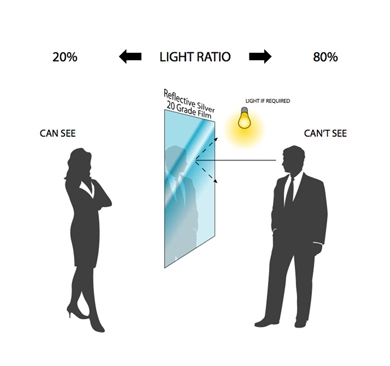
A one-way mirror, also known as a two-way mirror, is a mirror that allows people on one side to see through it while people on the other side see a reflection. One-way mirrors are made of a special type of glass that is coated with a thin layer of metal. The metal coating allows light to pass through in one direction, but reflects it in the other direction.
One-way mirrors, known as two-way mirrors or semi-transparent mirrors, possess unique features that allow them to reflect light on one side while allowing light to pass through from the other side. one-way mirrors offer a unique combination of reflective and transparent properties, making them versatile and valuable for various applications ranging from security and surveillance to decorative and architectural uses.
Thickness range | 2mm, 3mm, 4mm, 5mm, 6mm etc; |
Size range | 2100 x 1200 x 5 mm, 2020x1162mm, 160 x 90 mm, or OEM size; |
Shape | OEM accepted; |
Treatment | chemical strengthen, tempered; |
Edge Finishing | C corner and C edge grinding; |
Type | silver half mirror and half ultra clear mirror; |
Reflection | 65%, or OEM; |
Translucent | 35%, or OEM; |
Reflectivity: One-way mirrors exhibit high reflectivity on one side, creating a mirrored effect when the area behind the mirror is brightly lit. This reflective surface acts as a mirror for observers on one side of the glass.
Transparency: Despite their reflective properties, one-way mirrors allow light to pass through from the opposite side, providing visibility into the area behind the mirror when it is less brightly lit compared to the observer's side. This transparency enables observation or surveillance from one side of the glass without being detected by those on the other side.
Optical Coating: One-way mirrors feature a thin optical coating applied to one surface of the glass, which creates the mirror effect. This coating typically consists of a layer of metal (such as silver or aluminum) that reflects light while still allowing some light transmission.
Lighting Conditions: The effectiveness of a one-way mirror depends on the difference in lighting conditions between the two sides of the glass. It works best when the area behind the mirror is brightly lit, causing the reflective surface to dominate, while the observer's side remains dimly lit, allowing light to pass through.
Privacy: One-way mirrors offer privacy for individuals on the reflective side by preventing those on the transparent side from seeing through the glass under normal lighting conditions. However, privacy may be compromised if the lighting conditions on both sides of the mirror are similar.
Security and Surveillance: One-way mirrors are commonly used in security and surveillance applications, such as observation rooms, interrogation rooms, and police lineup rooms. They allow security personnel to observe subjects discreetly without alerting them to being watched.
Decorative and Architectural Applications: One-way mirrors are also used in decorative and architectural applications, such as mirrored glass facades, partitions, and artistic installations. They can create visually striking effects while providing privacy or concealing areas from view.
Rearview and Side Mirrors: One of the most common applications of one-way mirror technology in vehicles is in rearview and side mirrors. A special coating can be applied to these mirrors to create an auto-dimming effect, which helps in reducing glare from the headlights of vehicles behind, especially at night. This technology improves driver comfort and reduces the risk of temporary blindness from bright lights, enhancing safety.
Window Tinting and Privacy: One-way mirror films are also used for window tinting, providing privacy for passengers inside the vehicle while allowing the driver and occupants to see outside clearly during the day. This application is particularly useful in limousines, VIP vehicles, and in some cases, commercial vehicles, where privacy is a priority. It also helps in reducing the amount of sunlight entering the vehicle, keeping the interior cooler and protecting upholstery from fading.
Integrated Displays: Advanced applications of one-way mirrors in automotive design include the integration of heads-up displays (HUDs) on the windshield. This technology allows for the projection of important information, such as speed, navigation directions, and safety alerts, directly onto the windshield in a way that is visible to the driver but not from the outside. This use of one-way mirror technology enhances driver safety by minimizing distractions and keeping the driver’s eyes on the road.
Driver Observation Mirrors: In buses and trains, one-way mirrors are used to allow drivers or conductors to observe passenger areas without drawing attention. This application is crucial for monitoring passenger safety and behavior, as well as for preventing vandalism and ensuring compliance with transportation rules and regulations.
Separation Panels: One-way mirrors are also used in the design of separation panels between the driver’s cabin and passenger area in some public transportation vehicles. This allows drivers to have a clear view of the passenger area for safety and monitoring purposes while maintaining their focus by minimizing visual distractions from the passenger side.
Safety and Emergency Features: In emergency vehicles, such as ambulances and police cars, one-way mirrors are used to ensure privacy for patients or detainees. Additionally, they can be part of the vehicle’s design to conceal emergency lighting systems. When the lights are off, they are not visible from the outside, but when activated, the lights become visible through the one-way mirror panel, ensuring clear visibility of the emergency signals to others on the road.
Pls contact us if you have any inquire or questions, thank you.
No.12111, JINGSHI ROAD, LIXIA DIST, JINAN CITY, SHANDONG PROVINCE, CHINA